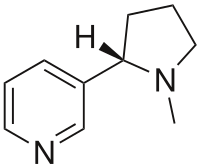
Photo from wikipedia
(1) Background: Varenicline is a widely prescribed agent in smoking cessation. However, the abstinence rate, the incidence of adverse events and withdrawal symptoms, have not been widely studied locally. This… Click to show full abstract
(1) Background: Varenicline is a widely prescribed agent in smoking cessation. However, the abstinence rate, the incidence of adverse events and withdrawal symptoms, have not been widely studied locally. This study aimed to determine the prevalence of smoking abstinence, adverse events and withdrawal symptoms associated with varenicline use, as well as possible factors contributing to successful smoking abstinence. (2) Methods: This was a retrospective, cohort study conducted in twenty-two government-operated smoking cessation clinics across the state of Perak, Malaysia. The medical records of adult smokers (age ≥ 18 years old) who were prescribed with varenicline between January 2017 and June 2018 were traced. The medical records of smokers who used pharmacotherapy other than varenicline, those who received less than four weeks of varenicline treatment, and with missing data were excluded. (3) Results: Sixty-eight out of 114 subjects (59.6%) successfully achieved smoking abstinence. Probable varenicline-induced chest pain was documented in three subjects. Altered behaviour (n = 2) and auditory hallucinations (n = 1) were also reported. Varenicline treatment duration is a significant predictive factor for successful smoking abstinence (odds ratio (OR) = 2.45; 95% confidence interval (CI) 1.74–3.45; p < 0.001), followed by age (OR = 1.25; 95% CI 1.005–1.564; p = 0.045), the presence of adverse events (OR = 0.096; 95% CI 0.014–0.644; p = 0.016) and withdrawal symptoms (OR = 0.032; 95% CI 0.016–0.835; p = 0.032). (4) Conclusion: Almost two-thirds of the subjects achieved smoking abstinence with varenicline. The duration of the treatment, as well as the patients’ ages had a significant influence on successful smoking abstinence. Rare cases of cardiovascular and neuropsychiatric-related adverse events were reported, warranting continuous surveillance and adverse drug reaction reporting.
Journal Title: International Journal of Environmental Research and Public Health
Year Published: 2022
Link to full text (if available)
Share on Social Media: Sign Up to like & get
recommendations!